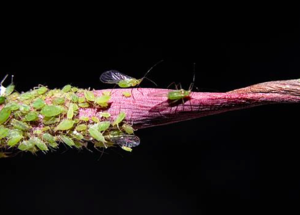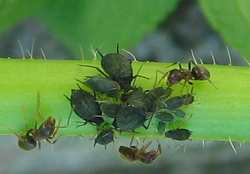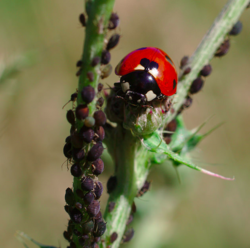
Aphids are small, soft bodied insects with a needle-like mouth that they use to suck sap. They stick their needle into the plant and extract the sugar as it is on its way down to the root.
Aphids are also known as plant lice, greenflies, blackflies or whiteflies, depending on where you reside.[1]
Aphids are destructive insects as far as gardeners and farmers in temperate regions are concerned.[1]
Spotting aphids[edit | edit source]
If you see a plant covered in ants, it's likely that the ants are herding aphids. They will pick up an aphid and move it to where they think they will get the best sugar. Then, when the aphid is nice and plump, they suck the sugar out of the aphid's anus.

Controlling aphids[edit | edit source]
Getting rid of aphids is easy for smaller areas where it's possible to introduce predatory insects or manually remove the aphids. Regular attendance to dealing with the aphids is an important part of minimising their impact on the plants.
For best results order some "aphid lion" (lacewing larvae) eggs. Ladybugs can be ordered too, but they tend to fly away before the job is done. Encourage them to stay by making ladybug "hotels" for them around the garden. Aphid lions don't have their wings yet, and have a big appetite for aphids.
Other natural enemies that can control aphids include crab spiders, hoverfly larvae, parasitic wasps and aphid midge larvae.[1] Entomopathogenic fungi such as Lecanicillium lecanii and the Entomophthorales are harmful to aphids.[1]
Running your fingers and thumb along strong stems and squashing aphids is also effective but not for the squeamish.
In some cases, depending on the plant, the aphids can be squirted off the plant(s), using a garden hose or spray bottle.
Homemade sprays can be effective against aphids too, such as a soapy garden spray.
In some cases, allowing some plants to be sacrifices to the aphids can enable other plants to thrive relatively unscathed. This is a bit of trial and error experimentation, but can be effective for fairly diverse gardens.

Sources and citations[edit | edit source]
See also[edit | edit source]
- Organic pesticides
- Soil improvement and fertilisation
- Crop protection
- How to practice sustainable agriculture
External links[edit | edit source]
- Wikipedia:
- Ants and Aphids on my Apple Tree - richsoil.com article with explanation and instructions on controlling ants and aphids, using various methods. Includes pictures and video.
- forum on ants and aphids at permies.com